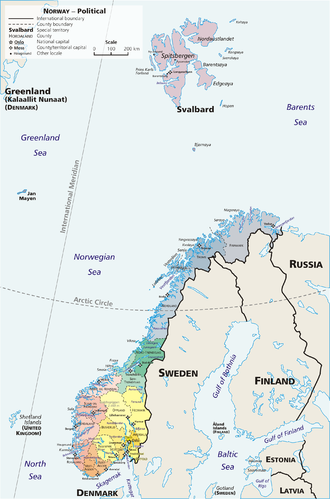Part of the country (Norway)

In this context, Spitzbergen and Jan Mayen remain a matter of their own.
The parts of the country (Norwegian sing. Landsdel , pl.Bokmål Landsdeler , Nynorsk Landsdelar ) of mainland Norway are not administrative administrative units, but historically grown regions with cultural peculiarities or a special identity :
The last four regions mentioned are grouped together as Sør-Norge (southern Norway).
Classification
If one follows a pragmatic delimitation of the parts of the country, the Norwegian Fylker can be assigned to them as follows:
| Part of the country | German | Population (2017) | Area (km²) | Number of Fylke | Fylke |
|---|---|---|---|---|---|
| North Norge | Northern Norway | 484,647 | 112,951 | 2 | Nordland , Troms and Finnmark |
| Trøndelag | Central Norway | 454,596 | 41,265 | 1 | Trøndelag |
| Vestlandet | Western Norway | 1,368,527 | 58,582 | 3 | Møre og Romsdal , Vestland , Rogaland |
| Østlandet | Eastern Norway | 2,649,758 | 94,596 | 4th | Innlandet , Oslo , Vestfold and Telemark , Viken |
| Sørlandet | Southern norway | 295,644 | 16,434 | 1 | Agder |
| all in all | 5,253,172 | 323,828 | 11 |
On the Concept part of the country beyond
The historical parts of the country are not to be confused with the seven areas of the same name, which are shown in the state statistics, see: NUTS: NO .
The term Midt-Norge (Central Norway) is geographically fuzzy and is varied as required.
Svalbard and the island of Jan Mayen also belong to Norway, but are outside the division into parts of the country, as this has usually remained limited to the mainland.
See also
Web links
Individual evidence
- ↑ The term was first coined in 1902 by the poet, writer and local researcher Vilhelm Krag . Before that it was generally considered part of the Vestlandet.
- ↑ Store norske leksikon
- ↑ Midt-Norge in the store norske leksikon .